Unit 3 How do you get to school? 复习课件 (共81张PPT)
文档属性
| 名称 | Unit 3 How do you get to school? 复习课件 (共81张PPT) | 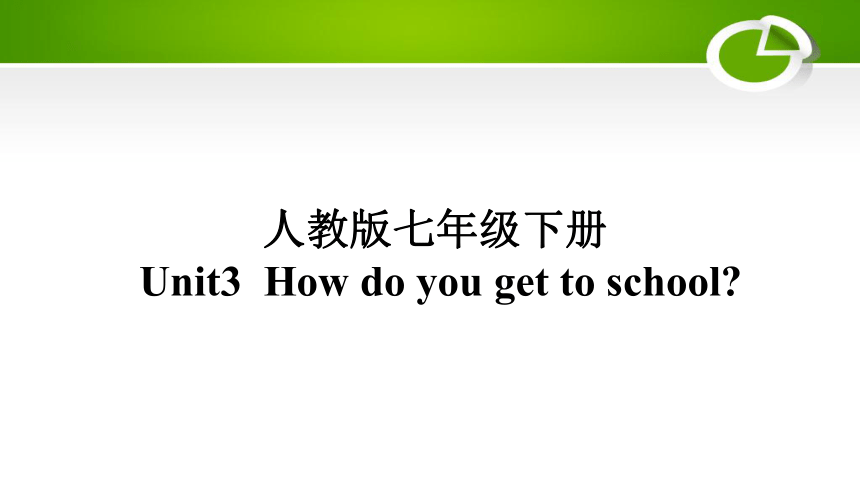 | |
| 格式 | pptx | ||
| 文件大小 | 32.1MB | ||
| 资源类型 | 教案 | ||
| 版本资源 | 人教新目标(Go for it)版 | ||
| 科目 | 英语 | ||
| 更新时间 | 2022-12-14 06:36:54 | ||
图片预览

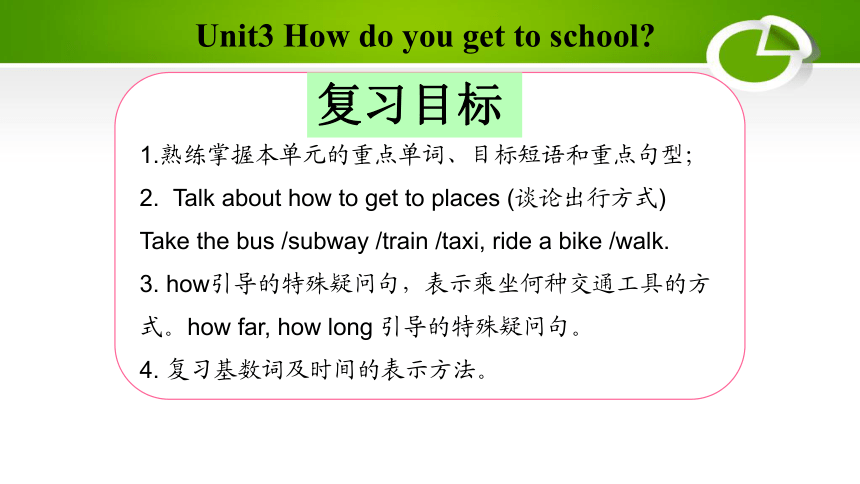
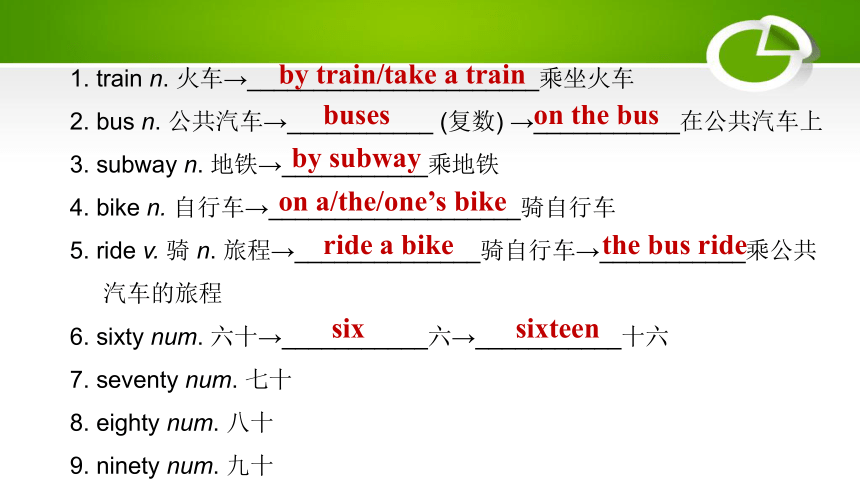
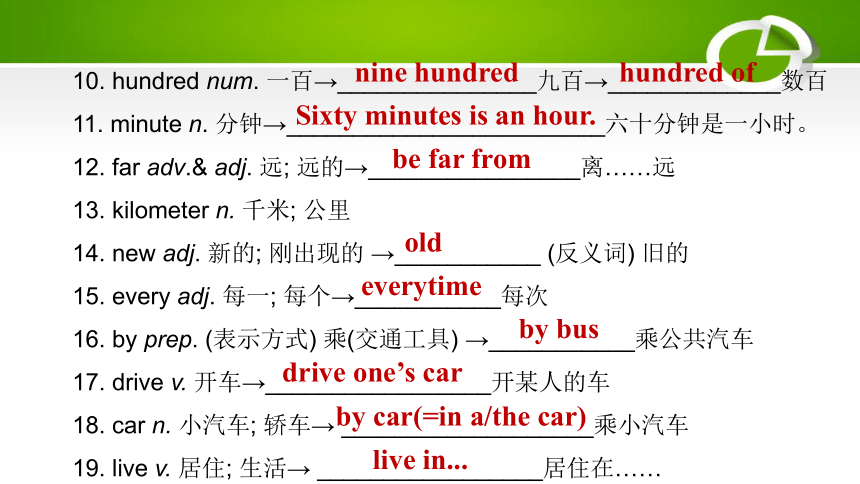
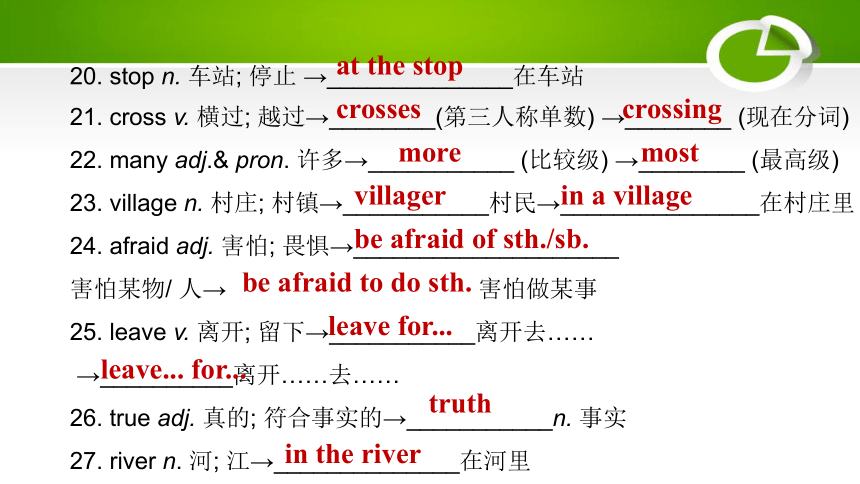
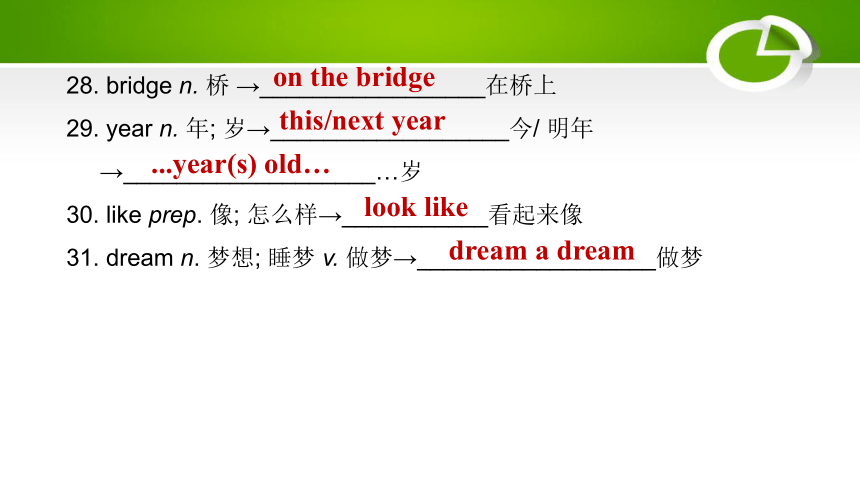
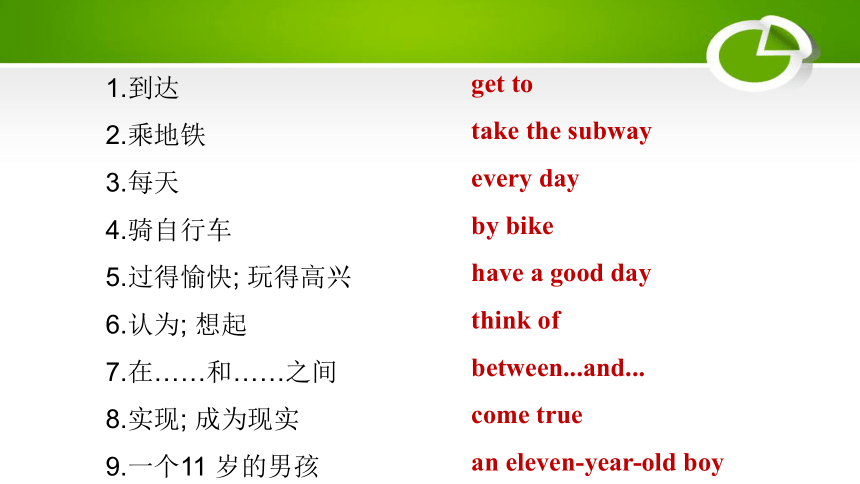
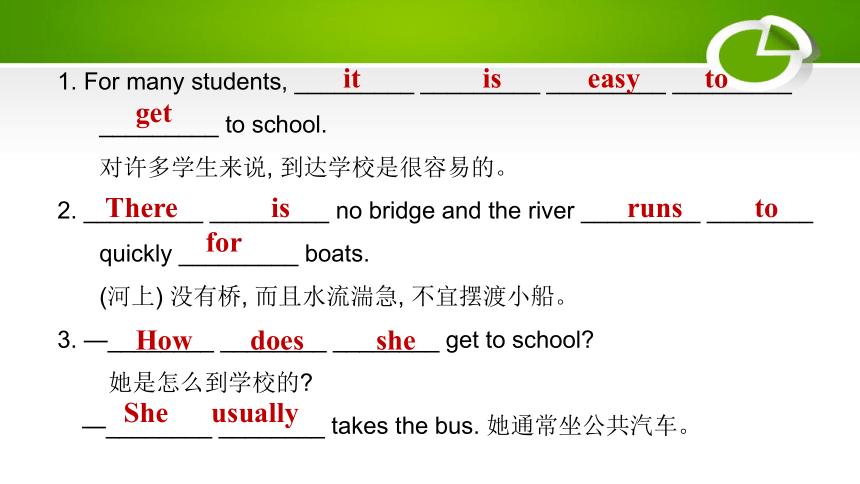
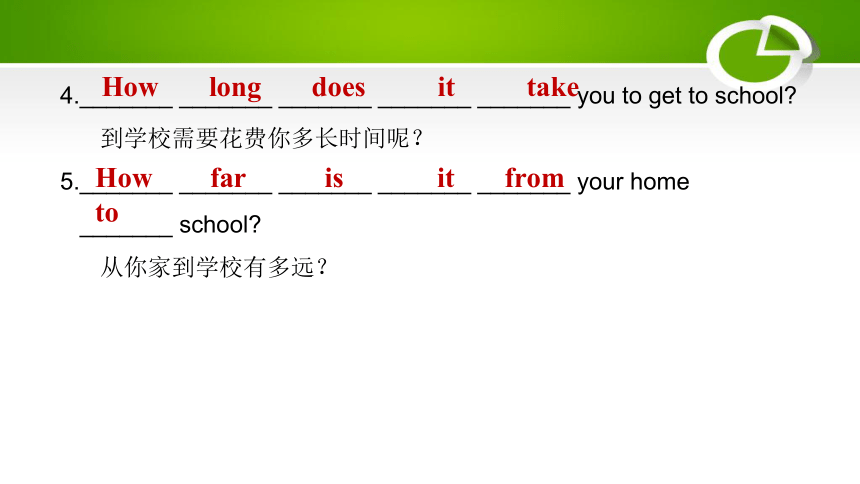
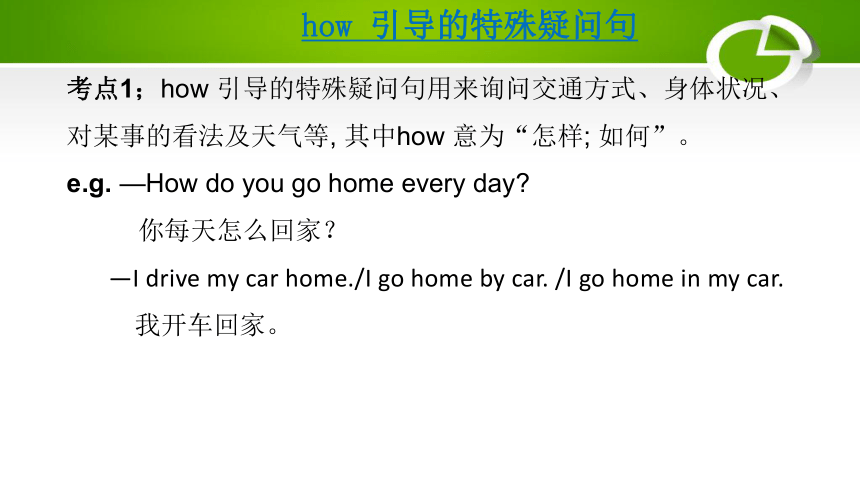
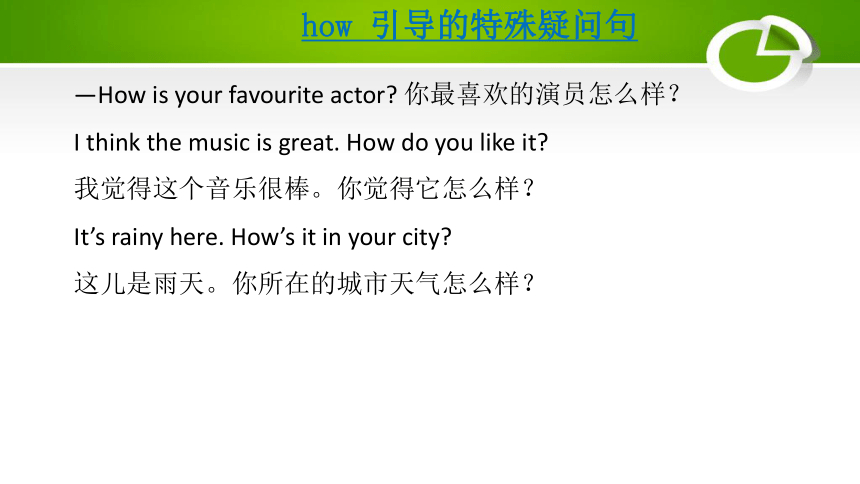
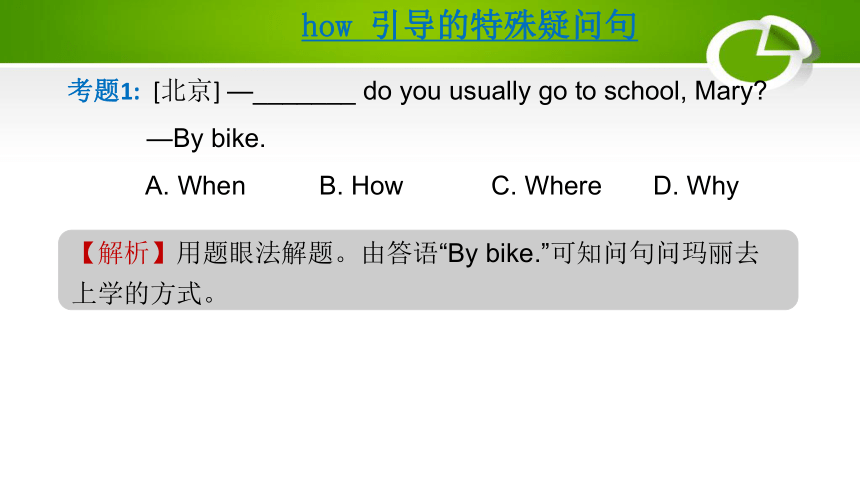
文档简介
(共81张PPT)
人教版七年级下册
Unit3 How do you get to school
Unit3 How do you get to school
1.熟练掌握本单元的重点单词、目标短语和重点句型;
2. Talk about how to get to places (谈论出行方式)
Take the bus /subway /train /taxi, ride a bike /walk.
3. how引导的特殊疑问句,表示乘坐何种交通工具的方式。how far, how long 引导的特殊疑问句。
4. 复习基数词及时间的表示方法。
复习目标
1. train n. 火车→______________________乘坐火车
2. bus n. 公共汽车→___________ (复数) →___________在公共汽车上
3. subway n. 地铁→___________乘地铁
4. bike n. 自行车→___________________骑自行车
5. ride v. 骑 n. 旅程→______________骑自行车→___________乘公共汽车的旅程
6. sixty num. 六十→___________六→___________十六
7. seventy num. 七十
8. eighty num. 八十
9. ninety num. 九十
by train/take a train
buses on the bus
by subway
on a/the/one’s bike
ride a bike
the bus ride
six sixteen
10. hundred num. 一百→_______________九百→_____________数百
11. minute n. 分钟→________________________六十分钟是一小时。
12. far adv.& adj. 远; 远的→________________离……远
13. kilometer n. 千米; 公里
14. new adj. 新的; 刚出现的 →___________ (反义词) 旧的
15. every adj. 每一; 每个→___________每次
16. by prep. (表示方式) 乘(交通工具) →___________乘公共汽车
17. drive v. 开车→_________________开某人的车
18. car n. 小汽车; 轿车→ ___________________乘小汽车
19. live v. 居住; 生活→ _________________居住在……
nine hundred hundred of
Sixty minutes is an hour.
be far from
old
everytime
by bus
drive one’s car
by car(=in a/the car)
live in...
20. stop n. 车站; 停止 →______________在车站
21. cross v. 横过; 越过→________(第三人称单数) →________ (现在分词)
22. many adj.& pron. 许多→___________ (比较级) →________ (最高级)
23. village n. 村庄; 村镇→___________村民→_______________在村庄里
24. afraid adj. 害怕; 畏惧→____________________
害怕某物/ 人→ 害怕做某事
25. leave v. 离开; 留下→___________离开去……
→__________离开……去……
26. true adj. 真的; 符合事实的→___________n. 事实
27. river n. 河; 江→______________在河里
at the stop
crosses crossing
more most
villager in a village
be afraid of sth./sb.
be afraid to do sth.
leave for...
leave... for...
truth
in the river
28. bridge n. 桥 →_________________在桥上
29. year n. 年; 岁→__________________今/ 明年 →___________________…岁
30. like prep. 像; 怎么样→___________看起来像
31. dream n. 梦想; 睡梦 v. 做梦→__________________做梦
on the bridge
this/next year
...year(s) old…
look like
dream a dream
1.到达
2.乘地铁
3.每天
4.骑自行车
5.过得愉快; 玩得高兴
6.认为; 想起
7.在……和……之间
8.实现; 成为现实
9.一个11 岁的男孩
get to
take the subway
every day
by bike
have a good day
think of
between...and...
come true
an eleven-year-old boy
1. For many students, _________ _________ _________ _________ _________ to school.
对许多学生来说, 到达学校是很容易的。
2. _________ _________ no bridge and the river _________ ________ quickly _________ boats.
(河上) 没有桥, 而且水流湍急, 不宜摆渡小船。
3. —________ ________ ________ get to school
她是怎么到学校的
—________ ________ takes the bus. 她通常坐公共汽车。
it is easy to
get
There is runs to
for
How does she
She usually
4._______ _______ _______ _______ _______ you to get to school
到学校需要花费你多长时间呢?
5._______ _______ _______ _______ _______ your home
_______ school
从你家到学校有多远?
How long does it take
How far is it from
to
考点1;how 引导的特殊疑问句用来询问交通方式、身体状况、对某事的看法及天气等, 其中how 意为“怎样; 如何”。
e.g. —How do you go home every day
你每天怎么回家?
—I drive my car home./I go home by car. /I go home in my car. 我开车回家。
how 引导的特殊疑问句
—How is your favourite actor 你最喜欢的演员怎么样?
I think the music is great. How do you like it
我觉得这个音乐很棒。你觉得它怎么样?
It’s rainy here. How’s it in your city
这儿是雨天。你所在的城市天气怎么样?
how 引导的特殊疑问句
考题1: [北京] —_______ do you usually go to school, Mary
—By bike.
A. When B. How C. Where D. Why
【解析】用题眼法解题。由答语“By bike.”可知问句问玛丽去上学的方式。
how 引导的特殊疑问句
考题2: [黄石] —Hey, Jane. ______ are you feeling now
—Much better. Thanks.
A. What B. Where
C. How D. When
【解析】用题眼法解题。由答语中的“Much better.”可知, 问句用How 提问。
how 引导的特殊疑问句
考点2;与how有关的疑问句
how long 用来提问时间长短, 意为“多长时间”; 用来询问物体的长度, 意为“多长”。
e.g. How long does it take you to finish your homework
完成家庭作业花费你多长时间?
How long is the river
这条河有多长?
问时间
问长度
how 引导的特殊疑问句
考题3: [福建] —________ have you been a member of the 、
Helpers’ Club
—For two years.
A. How soon B. How long C. How often
【解析】用语法分析法解题。How soon“多久”,对将来的时间进行提问,回答时一般用In 加上时间段;How long“多长时间”,对一段时间提问;How often“多久一次”,对频率提问。由答语“两年。”可知是对一段时间提问。
how 引导的特殊疑问句
考点3;how far 用来提问距离, 意为“多远”。其答语分为两种情况:
(1) 用长度单位表示
e.g. —How far is it from your home to the bus stop
从你家到公共汽车停靠站有多远?
—It’s two kilometers. 两公里远。
how 引导的特殊疑问句
(2) 用时间表示
e.g. —How far is the park from the supermarket
公园离超市有多远?
—It’s 5 minutes’ walk. (=It’s 5 minutes on foot.)
步行5 分钟的路程。
how 引导的特殊疑问句
考题; —_______ is China Tiangong space station from us
—About 400 kilometers above the earth.
A. How much B. How often
C. How far D. How long
【解析】由答语“距离地球约400 公里。”可知上句是询问距离。How far意为“多远”,用于对距离进行提问。
how 引导的特殊疑问句
考题;—________ is it from your home to school, Alice
—About fifteen minutes’ walk.
A. How often B. How far
C. How many D. How much
【解析】用逻辑推理法解题。由答语“步行大约15 分钟。”可知,问句问的是路程有多远。
how 引导的特殊疑问句
考点4;how often 意为“多久一次”, 询问做某事的频率。
eg. How often does Lucy visit her aunt
露西多久看望一次她姑妈?
考题;—________ do you play volleyball, Amy
—Three days a week.
A. How long B. How soon
C. How often D. How much
how 引导的特殊疑问句
考点5;how soon 意为“多久以后”, 常用于一般将来时。
e.g. —How soon will she be back 她多久以后能回来?
—She will be back in 3 months.3 个月以后她将会回来。
考题7: —Dad, ________ will my mom come back I miss her
very much.
—In a month.
A. how soon B. how often
C. how long D. how far
how 引导的特殊疑问句
考点6;how about... 意为“……怎么样”, 相当于“what
about...”。
e.g. How about going to the beaches for a vacation
去海滩度假怎么样?
考题: —Li Lin, ________ playing football this Sunday
—That sounds like a good idea.
A. why not B. how about
C. what D. where
how 引导的特殊疑问句
take the bus
考点1;bus /b s/ n. 公共汽车
take the bus 意为“乘公共汽车”, 是“take + the/a +交通工具”的结构, 用来表示乘坐某种交通工具, 意为“乘……; 坐……”, 相当于“go to...by+交通工具”。
take the/a train 乘火车 take the/a car 乘小汽车
take the/a plane 乘飞机 take the/a subway 乘地铁
take the/a taxi 乘出租车
the 可以替换为a
考点精讲
e.g. There are lots of buses in the city.
城市里有许多公共汽车。
My brother usually takes the/a bus to work.
=My brother usually goes to work by bus.
我哥哥通常乘公共汽车去上班。
take the bus
by和bus之间没有冠词或其他限定词,且bus 不用复数。
复数形式
考点精讲
take the/a bus 乘坐公共汽车(动作) He often takes the/a bus to work.
他经常乘坐公共汽车去上班。
on the/a bus 在公共汽车上 They are talking on the bus.
他们正在公共汽车上交谈。
take the bus
考点2;辨析: take the/a bus与on the /a bus
易错点:与bus用法相同的单词有train, subway,car 等,但car 之前的介词用in。
考点精讲
考题1;—Does your teacher go to work by ____ car every day
—No. He usually takes _________ bus.
A. /; / B. /; the C. a; the D. the; a
考题2;Kate takes a bus to school every day. (改为同义句)
Kate goes to school _________ _________ every day.
考点精讲
how do you go to school
考点1;【句法分析】“How do/does sb. get to... ” 意为“某人如何到达……?”, 这是用来询问交通方式的交际用语。其答语主要有以下几种:
① Sb. take(s) /drive(s) /ride(s) +a/the/one’s+ 交通工具.【注意:当表示“步行”时, 要用Sb. walk(s) .】
考点精讲
how do you go to school
② Sb. get(s) to ... by+ 交通工具./By+ 交通工具./On foot.
③ Sb. get(s) to... on/in+a/the/one’s+ 交通工具.
e.g. —How do you come to the club
你怎么来俱乐部的?
—By bus./I take the bus.
(我) 乘公共汽车。
交通方式的表达:
by+交通工具
take a /the+ 交通工具
drive+冠词/物主代词+交通工具
ride+ 冠词/物主代词+交通工具
考点精讲
考题1;—________ do the students in the village go to school
—On a ropeway.
A. How B. When C. Where
考题2;—How are you going to Shanghai, Harry
—_______ plane.
A. Of B. In C. By
考点精讲
get to 到达
后接地点名词, 表示“到达某地”, get to 后接副词home, here, there 等时, 要去掉to。
e.g. They will get to Mount Tai soon.他们很快就能到达泰山了。
get to
考题;On weekdays, we must ________ ________ school
before 7:30 in the morning. (到达)
考点精讲
考点1;hundred /h ndr d/ num. 一百
hundred
辨析: hundred与hundreds of
hundred 前面有具体数字时, 用“基数词+hundred”表示“几百”。
hundreds of “数百”, 表示概数, 此时不能与数词连用, 但可以与many, several 等连用。
速记小法:
前有具体数字无s无of;
表示模糊概念有s有of。
考点精讲
e.g. There are eight hundred students in our school.
在我们学校有八百个学生。
Hundreds of people are eating in the restaurant.
数百人正在餐馆吃饭。
拓展:与hundred 有类似用法的单词还有thousand, million, billion 等。
注意:用英语表示“几百几十几”时,应在百位数和十位数或个位数之间加and。
356 three hundred and fifty-six
208 two hundred and eight
hundred
考点精讲
考题;There are ________ paintings on exhibition (展览).
________ works were created by young artists.
A. two hundred; Two hundreds
B. two hundreds; Hundreds of
C. hundreds of; Two hundred
hundred
考点精讲
考点1;every day 每天
every day
辨析:every day 与everyday
every day 副词性短语, 在句中作时间状语, 常用于一般现在时中。
everyday 作形容词, 意为“每天的; 日常的”, 可作定语修饰名词。
一语辨异:I study everyday English every day. 我每天学习日常英语。
考点精讲
考点2;every /evri/ adj. 每一; 每个
e.g. He knows every student in our class.
他认识我们班上的每一个学生。
Every student gets to school on time.
每个学生都按时到校。
every指三者或三者以上的人或事物中的“每一个”。every 后接可数名词单数;“every+ 可数名词单数”作主语时,谓语动词用单数形式。
可数名词单数
第三人称单数
考点精讲
考点1;交际用语:How far is it from...to... 意为“从……到……多远?”用来询问距离或路程的远近。
—How far is it from the bookstore to the supermarket
从书店到超市多远
—About 2 kilometers. 大约2 千米。
how far
考点精讲
交际用语:I’m not sure. “ 我不确定” 是表达自己对判断没有十足把握的固定用语。
e.g. —How about John 约翰呢?
—I think he will go with us, but I’m not sure.
我认为他会跟我们一起去, 但我不确定。
sure
be sure of sth.对某事有把握;确信……
be sure to do sth.一定做某事;务必做某事
be sure+that 从句 确信……
考点精讲
考题;—Will you join in the discussion tomorrow
—_______ Maybe I’ll have a meeting.
A. Well, I’m not sure. B. That’ll be great!
C. Certainly. D. You’re welcome.
sure
【解析】用语境判定法解题。由答语后面“可能我要开会。”可知,“我”不能确定明天是否可以参加讨论。“I’m not sure”意为“我不确定”。
考点精讲
※考点1;how long 意为“多长时间”, 用来询问时间的长短, 其谓语动词应是延续性动词, 答语常用表示一段时间的名词性短语。
e.g. —How long does he live in the village
他在这个村住了多长时间?
—About a year. 大约一年。
(说明:how long 的详细用法见本单元语法沙龙)
how long
考点精讲
考点1;It takes (sb.) some time to do sth. 做某事花费(某人) 一些时间。
e.g. It usually takes him two hours to get home from work.
通常下班后回家要花费他两个小时的时间。
take
此句型中It为形式主语,真正的主语是后面的动词不定式“to do sth.”。
take在此处意为“花费”
考点精讲
考题;Roy works in London. It _______ him about half an
hour to get to work by bus every day.
A. costs B. spends C. takes
take
【解析】用固定句式法解题。“It takes sb.+ 时间+to do sth.”是固定句型, 意为“做某事花费某人多长时间”。
考点精讲
考点1;【句法分析】这是关于交通方式的一般疑问句,本句主语是第三人称单数, 用助动词does 来构成一般疑问句及其否定回答。当主语不是第三人称单数时, 要用助动词do 来构成一般疑问句及其否定回答。
Does Jane walk to school
肯定答语为:Yes,主语+does/do.
当表示地点的词是名词时,用walk to...;
当表示地点的词是here, there, home等副词时,要省略to。
考点精讲
e.g. —Do they take the bus to school
他们乘公共汽车去上学吗?
—No, they don’t. They walk.
不, 他们不是。他们步行。
Does Jane walk to school
考点精讲
Does Jane walk to school
考点2;walk to... 步行去……
e.g. All the students walk to school every day.
=All the students go to school on foot every day.
所有的学生每天步行去上学。
相当于go to...on foot
考点精讲
考点1;stop /st p/ n. 车站;停止
bus stop
stop 用作名词:
at the bus stop 在公共汽车站
come to a stop 停下来
辨析: stop 与station
stop “车站”,一般指公共汽车在路上停留、乘客上下车的小站点。
station “车站”,规模较大的车站,一般指始发站和终点站。
考点精讲
考点2;stop 既可作名词,也可作动词,意为“停止”。
e.g. The car comes to a stop. 汽车停了下来。
Let’s stop to have a rest.
咱们停下来(原来干的事),(去) 休息一下吧。
Stop talking, please. 请停止(正在) 说话(这个动作)。
His mother stops him from watching TV.
他妈妈阻止他看电视。
bus stop
考点精讲
stop 用作动词,常用短语:
stop to do sth.停下来去做某事(停止这件事去做另一件事)
stop doing sth.停止做某事(停止正在做的事)
stop sb. from doing sth.阻止某人做某事
bus stop
考点精讲
考点1;句中where Bob lives 是宾语从句,作know 的宾语,是陈述语序。
e.g. He doesn’t know what his father’s favourite music is.
他不知道他父亲最喜欢的音乐是什么。
where Bob lives
注意:在含有宾语从句的主从复合句中,宾语从句要用陈述语序。
考点精讲
考题; —I can’t find you.
—I don’t know ________. I’m on the left of a tree.
A. who I am B. who am I
C. where I am D. where am I
where Bob lives
考点精讲
考点1;think of 认为;想起
“What do you think of... ”相当于“How do you like... ”,用来询问对某事、某物或某人的看法。回答时要说出具体的看法或意见。
think of
of后可接名词、代词或动词的-ing形式作宾语
考点精讲
I can’t think of your telephone number.
我想不起你的电话号码了。
—What do you think of the movie
=How do you like the movie 你觉得这部电影怎么样
—It’s great. I love it. 太棒了。我喜欢。
think of
有关 think的其他短语:
think about
思考,考虑
think over
仔细考虑
考点精讲
考题:—________
—It’s very interesting.
A. What do you think of the book
B. Do you like the interesting book
C. Let’s go to watch a book.
D. How can you go to the book
think of
考点精讲
think of 意为“想起”,与remember 同义。
e.g. This old picture lets him think of his good friend.
这张旧照片让他想起了他的好朋友。
think of
考题;—What’s up, Lisa
—I have to hand in the report tomorrow, but I can’t _______ anything to write.
A. talk of B. think of C. speak of D. hear of
考点精讲
考点1;cross /kr s/, /kr s / v. 横过;越过
cross
辨析:cross,across 和crossing
cross 动词,意为“横过;越过”。 cross=go across
across 介词或副词,意为“横过” crossing 名词,意为“十字路口”。 cross还可用作名词,意为“十字形或叉字形记号”
考点精讲
Please be careful when you cross the road.
当你过马路时请小心。
Go across/Cross the street and you can find it.
穿过这条街道你就能找到它。
Turn left at the second crossing.
在第二个十字路口向左拐。
cross
考点精讲
考点1;※【句法分析】本句是“It is + adj. + (of/for sb. + ) to do sth.”结构,意为“(某人/ 对某人来说) 做某事是……的”。其中It 为形式主语,后面的动词不定式短语“to do sth.” 是句子的真正主语。本句为了强调,把for many students 放到了句首。正常的语序应是“It is easy for many students to get to school.”。
it is easy to get to school.
考点精讲
考题;It’s important for us ________ hard in order to
have a better life.
A. work B. to work C. working
it is easy to get to school.
考点精讲
拓展;辨析:It is + adj. + for/of sb. + to do sth. 句型中的for 和of
① It is + adj. + for sb. + to do sth. 中的for 后跟对象,意为“就……而言;对……来说”, 句中的形容词是描述事物特征的。
It is difficult for me to speak French.
对我来说,说法语是困难的。
it is easy to get to school.
考点精讲
② It is+adj.+of sb.+to do sth.中的形容词是表示人的特点、性格或特征的。
It is nice of you to help me. 帮助我你真是太好了。
it is easy to get to school.
考题;—It is convenient ________ us ________ things online.
—So it is.
A. for; to buy B. of; to buy C. for; buy
考点精讲
考点1;辨析many/much与lots of
many
many 修饰可数名词复数 There are many trees in the park.
公园里有许多树。
much修饰不可数名词 There is much pollution in the town.
这个城镇污染很严重。
lots of=a lot of 既可修饰可数名词复数,又可修饰不可数名词 You can see lots of trees/water over there. 在那边你能看到许多树/ 水。
考点精讲
考题; Tom has made quite a few good friends since he
came to China to learn Chinese. _______
A. only a few B. two or three
C. much D. many
many
考点精讲
考点1;【句法分析】本句是there be 句型,结构为“There be+ 某人/某物+ 某地/ 某时.”,意为“某地或某时有某人或某物”。
e.g. There are four men and a woman using WeChat.
有四位男士和一位女士正在使用微信。
there be
当有两个或两个以上并列主语时,there be句型遵循“就近原则”,即be动词取决于离它最近的名词的单复数。
与four men 保持一致
考点精讲
考题;There ________ some milk and several apples in the
fridge.
A. is B. are C. be
there be
【解析】“there be”句型遵循“就近原则”,离be 动词最近的名词milk 是不可数名词,所以be 动词要用is。
考点精讲
考点1;between /b twi n/ prep. 介于……之间
between
between 一般用于两者之间,其宾语往往是表示两者的名词或代词,或是由and 连接的两个人或事物。
among 表示三者或三者以上的人或物之间,宾语可以是复数名词或代词,也可以是集合名词。
辨析:between 与among
当有两个或两个以上并列主语时,there be 句型遵循 “就近原则”,即be 动词取决于离它最近的名词的单复数。
考点精讲
e.g. This village lies between two mountains.
这个村庄位于两座山之间。
That village lies among the mountains.
那个村庄位于群山之中。
There is a road between this village and that one.
在这个村庄和那个村庄之间有一条路。
between
between...and... 意为
“在……和……之间”。
考点精讲
考题;The high-speed train ________ Qingdao and Beijing
travels faster now. The train ride takes only about three
hours.
A. from B. among C. in D. between
【解析】用固定搭配法解题。句意为“现在青岛与北京之间的高铁行驶速度更快了。火车行程仅花费大约三个小时”。between …and... 意为“在……和……之间”是固定搭配。
there be
考点精讲
考点1;11-year-old 11 岁的 是由“基数词+单数名词+形容词”构成的复合形容词,常用来作定语。
e.g. This is an 8-month-old baby.
这是一个八个月大的婴儿。
It’s a 300-meter-long bridge.
它是一座长300 米的桥。
11-year-old
8 的英文是eight,以元音音素开头,前面的不定冠词用an
考点精讲
11-year-old
11-year-old 用连字符连接,中间的名词用单数,在句中作定语。
11 years old 不用连字符连接,中间的名词用复数,在句中作表语。
e.g. He is an 11-year-old boy. 他是一个11 岁大的男孩。
She is 11 years old. 她11 岁了。
a three-meter-long snake 一条3 米长的蛇
考点精讲
考题;—The ________ girl has won the prize of International
Master of Memory.
—Wow, she’s great, isn’t she
A. ten-year-old B. ten-years-old
C. ten year old D. ten years old
11-year-old
考点精讲
考点1;afraid / fre d/ adj. 害怕;畏惧
afraid
be afraid to do sth. 表示“害怕做某事”,即主语对做某事感到恐惧。 He was afraid to go out alone at night.
他害怕晚上独自外出。
be afraid of (doing) 表示主语内心不情愿做某事,担心某事可能发生。 She was afraid of waking her husband up.
她怕吵醒她丈夫。
辨析: be afraid to do sth.与 be afraid of (doing) sth.
考点精讲
考题;根据括号内的汉语提示补全句子
I _________________ (害怕) crossing the street
because there is always too much traffic.
afraid
考点精讲
考点1;leave /li v/ v. 离开
Let’s leave at 6:00. 让我们6 点离开吧。
He leaves home early every day. 每天他早早地离开家。
leave
考点精讲
leave 后跟的地点为“出发地” When do you leave school
你什么时候离校?
leave for 后跟的地点为“目的地” He will leave for Shanghai tomorrow.
明天他将动身去上海。
leave A for B A 为“出发地” B 为“目的地” He wants to leave Beijing for Shanghai.
他想离开北京去上海。
辨析: leave, leave for 与leave A for B
leave
考点精讲
拓展:leave 还可意为“留下;丢下;剩余”等。
e.g. I left my schoolbag at home.
我把我的书包落在家了。
Hurry up! There’s little time left.
快点!几乎没有时间了。
leave
考点精讲
韩诚是你的朋友,他在一所中学上学。他家离学校约2 公里,他通常骑自行车上学,大约用时15 分钟。下雨的时候他爸爸开车送他。他的父母在离家10 公里的一家工厂上班,他们每天开车上班,大约需要20 分钟。他觉得骑自行车……
请根据提示写一篇不少于80 词的短文。
单元话题
1.注意写作时应用一般现在时,要用第三人称,且要包括以上所有信息。
2.表达交通方式、距离、花费时间的句型要恰当、合理。如:“by+ 交通工具” 、“take/drive/ride the+交通工具”、“It takes + sb.+ 时间+to do sth.”等。
审题指导
“三步法”写如何到达目的地
第一步:点明目的地;
第二步:详细介绍交通方式;
第三步:谈感受。
写作方法
写作模板
开篇点题
具体描述
总结全文
上午活动
上午活动
上午活动
HanCheng.studies in ....
His home is...he usually rides a bike...
But when it rains.....
His mother and father...it's......
HanCheng likes ...because he thinks it's.....
单词 home, kilometer, factory, car, minute
短语 ride a bike, in one’s car, take the bus, by taxi/car...
句子 ① It takes sb. +时间+ to do sth.
② It’s +距离+ from ...
常用词句
Han Cheng is my friend. He studies in a middle school. His home is about two kilometers from his school. He usually rides a bike to school and it takes him about fifteen minutes to get to school.① But when it rains, he goes to school in his father’s car.② His father and mother both work in a factory. It’s ten kilometers from their home. They drive a car to work every day. It takes them about twenty minutes to get there.
点明目的地:school,factory;
交通方式;rides a bike, in his father’s car, drive a car;
灵活运用句型“It takes sb. +时间+to do sth.”来介绍到目的地所花费的时间;
Han Cheng likes going to school by bike because he thinks it’s good exercise and it’s good for the environment.③
表明韩诚对于自己到校方式的看法:good exercise, good for the environment。
用because引导的原因状语从句表明自己喜欢骑自行车去上学的原因,增强了短文的逻辑性。
人教版七年级下册
Unit3 How do you get to school
Unit3 How do you get to school
1.熟练掌握本单元的重点单词、目标短语和重点句型;
2. Talk about how to get to places (谈论出行方式)
Take the bus /subway /train /taxi, ride a bike /walk.
3. how引导的特殊疑问句,表示乘坐何种交通工具的方式。how far, how long 引导的特殊疑问句。
4. 复习基数词及时间的表示方法。
复习目标
1. train n. 火车→______________________乘坐火车
2. bus n. 公共汽车→___________ (复数) →___________在公共汽车上
3. subway n. 地铁→___________乘地铁
4. bike n. 自行车→___________________骑自行车
5. ride v. 骑 n. 旅程→______________骑自行车→___________乘公共汽车的旅程
6. sixty num. 六十→___________六→___________十六
7. seventy num. 七十
8. eighty num. 八十
9. ninety num. 九十
by train/take a train
buses on the bus
by subway
on a/the/one’s bike
ride a bike
the bus ride
six sixteen
10. hundred num. 一百→_______________九百→_____________数百
11. minute n. 分钟→________________________六十分钟是一小时。
12. far adv.& adj. 远; 远的→________________离……远
13. kilometer n. 千米; 公里
14. new adj. 新的; 刚出现的 →___________ (反义词) 旧的
15. every adj. 每一; 每个→___________每次
16. by prep. (表示方式) 乘(交通工具) →___________乘公共汽车
17. drive v. 开车→_________________开某人的车
18. car n. 小汽车; 轿车→ ___________________乘小汽车
19. live v. 居住; 生活→ _________________居住在……
nine hundred hundred of
Sixty minutes is an hour.
be far from
old
everytime
by bus
drive one’s car
by car(=in a/the car)
live in...
20. stop n. 车站; 停止 →______________在车站
21. cross v. 横过; 越过→________(第三人称单数) →________ (现在分词)
22. many adj.& pron. 许多→___________ (比较级) →________ (最高级)
23. village n. 村庄; 村镇→___________村民→_______________在村庄里
24. afraid adj. 害怕; 畏惧→____________________
害怕某物/ 人→ 害怕做某事
25. leave v. 离开; 留下→___________离开去……
→__________离开……去……
26. true adj. 真的; 符合事实的→___________n. 事实
27. river n. 河; 江→______________在河里
at the stop
crosses crossing
more most
villager in a village
be afraid of sth./sb.
be afraid to do sth.
leave for...
leave... for...
truth
in the river
28. bridge n. 桥 →_________________在桥上
29. year n. 年; 岁→__________________今/ 明年 →___________________…岁
30. like prep. 像; 怎么样→___________看起来像
31. dream n. 梦想; 睡梦 v. 做梦→__________________做梦
on the bridge
this/next year
...year(s) old…
look like
dream a dream
1.到达
2.乘地铁
3.每天
4.骑自行车
5.过得愉快; 玩得高兴
6.认为; 想起
7.在……和……之间
8.实现; 成为现实
9.一个11 岁的男孩
get to
take the subway
every day
by bike
have a good day
think of
between...and...
come true
an eleven-year-old boy
1. For many students, _________ _________ _________ _________ _________ to school.
对许多学生来说, 到达学校是很容易的。
2. _________ _________ no bridge and the river _________ ________ quickly _________ boats.
(河上) 没有桥, 而且水流湍急, 不宜摆渡小船。
3. —________ ________ ________ get to school
她是怎么到学校的
—________ ________ takes the bus. 她通常坐公共汽车。
it is easy to
get
There is runs to
for
How does she
She usually
4._______ _______ _______ _______ _______ you to get to school
到学校需要花费你多长时间呢?
5._______ _______ _______ _______ _______ your home
_______ school
从你家到学校有多远?
How long does it take
How far is it from
to
考点1;how 引导的特殊疑问句用来询问交通方式、身体状况、对某事的看法及天气等, 其中how 意为“怎样; 如何”。
e.g. —How do you go home every day
你每天怎么回家?
—I drive my car home./I go home by car. /I go home in my car. 我开车回家。
how 引导的特殊疑问句
—How is your favourite actor 你最喜欢的演员怎么样?
I think the music is great. How do you like it
我觉得这个音乐很棒。你觉得它怎么样?
It’s rainy here. How’s it in your city
这儿是雨天。你所在的城市天气怎么样?
how 引导的特殊疑问句
考题1: [北京] —_______ do you usually go to school, Mary
—By bike.
A. When B. How C. Where D. Why
【解析】用题眼法解题。由答语“By bike.”可知问句问玛丽去上学的方式。
how 引导的特殊疑问句
考题2: [黄石] —Hey, Jane. ______ are you feeling now
—Much better. Thanks.
A. What B. Where
C. How D. When
【解析】用题眼法解题。由答语中的“Much better.”可知, 问句用How 提问。
how 引导的特殊疑问句
考点2;与how有关的疑问句
how long 用来提问时间长短, 意为“多长时间”; 用来询问物体的长度, 意为“多长”。
e.g. How long does it take you to finish your homework
完成家庭作业花费你多长时间?
How long is the river
这条河有多长?
问时间
问长度
how 引导的特殊疑问句
考题3: [福建] —________ have you been a member of the 、
Helpers’ Club
—For two years.
A. How soon B. How long C. How often
【解析】用语法分析法解题。How soon“多久”,对将来的时间进行提问,回答时一般用In 加上时间段;How long“多长时间”,对一段时间提问;How often“多久一次”,对频率提问。由答语“两年。”可知是对一段时间提问。
how 引导的特殊疑问句
考点3;how far 用来提问距离, 意为“多远”。其答语分为两种情况:
(1) 用长度单位表示
e.g. —How far is it from your home to the bus stop
从你家到公共汽车停靠站有多远?
—It’s two kilometers. 两公里远。
how 引导的特殊疑问句
(2) 用时间表示
e.g. —How far is the park from the supermarket
公园离超市有多远?
—It’s 5 minutes’ walk. (=It’s 5 minutes on foot.)
步行5 分钟的路程。
how 引导的特殊疑问句
考题; —_______ is China Tiangong space station from us
—About 400 kilometers above the earth.
A. How much B. How often
C. How far D. How long
【解析】由答语“距离地球约400 公里。”可知上句是询问距离。How far意为“多远”,用于对距离进行提问。
how 引导的特殊疑问句
考题;—________ is it from your home to school, Alice
—About fifteen minutes’ walk.
A. How often B. How far
C. How many D. How much
【解析】用逻辑推理法解题。由答语“步行大约15 分钟。”可知,问句问的是路程有多远。
how 引导的特殊疑问句
考点4;how often 意为“多久一次”, 询问做某事的频率。
eg. How often does Lucy visit her aunt
露西多久看望一次她姑妈?
考题;—________ do you play volleyball, Amy
—Three days a week.
A. How long B. How soon
C. How often D. How much
how 引导的特殊疑问句
考点5;how soon 意为“多久以后”, 常用于一般将来时。
e.g. —How soon will she be back 她多久以后能回来?
—She will be back in 3 months.3 个月以后她将会回来。
考题7: —Dad, ________ will my mom come back I miss her
very much.
—In a month.
A. how soon B. how often
C. how long D. how far
how 引导的特殊疑问句
考点6;how about... 意为“……怎么样”, 相当于“what
about...”。
e.g. How about going to the beaches for a vacation
去海滩度假怎么样?
考题: —Li Lin, ________ playing football this Sunday
—That sounds like a good idea.
A. why not B. how about
C. what D. where
how 引导的特殊疑问句
take the bus
考点1;bus /b s/ n. 公共汽车
take the bus 意为“乘公共汽车”, 是“take + the/a +交通工具”的结构, 用来表示乘坐某种交通工具, 意为“乘……; 坐……”, 相当于“go to...by+交通工具”。
take the/a train 乘火车 take the/a car 乘小汽车
take the/a plane 乘飞机 take the/a subway 乘地铁
take the/a taxi 乘出租车
the 可以替换为a
考点精讲
e.g. There are lots of buses in the city.
城市里有许多公共汽车。
My brother usually takes the/a bus to work.
=My brother usually goes to work by bus.
我哥哥通常乘公共汽车去上班。
take the bus
by和bus之间没有冠词或其他限定词,且bus 不用复数。
复数形式
考点精讲
take the/a bus 乘坐公共汽车(动作) He often takes the/a bus to work.
他经常乘坐公共汽车去上班。
on the/a bus 在公共汽车上 They are talking on the bus.
他们正在公共汽车上交谈。
take the bus
考点2;辨析: take the/a bus与on the /a bus
易错点:与bus用法相同的单词有train, subway,car 等,但car 之前的介词用in。
考点精讲
考题1;—Does your teacher go to work by ____ car every day
—No. He usually takes _________ bus.
A. /; / B. /; the C. a; the D. the; a
考题2;Kate takes a bus to school every day. (改为同义句)
Kate goes to school _________ _________ every day.
考点精讲
how do you go to school
考点1;【句法分析】“How do/does sb. get to... ” 意为“某人如何到达……?”, 这是用来询问交通方式的交际用语。其答语主要有以下几种:
① Sb. take(s) /drive(s) /ride(s) +a/the/one’s+ 交通工具.【注意:当表示“步行”时, 要用Sb. walk(s) .】
考点精讲
how do you go to school
② Sb. get(s) to ... by+ 交通工具./By+ 交通工具./On foot.
③ Sb. get(s) to... on/in+a/the/one’s+ 交通工具.
e.g. —How do you come to the club
你怎么来俱乐部的?
—By bus./I take the bus.
(我) 乘公共汽车。
交通方式的表达:
by+交通工具
take a /the+ 交通工具
drive+冠词/物主代词+交通工具
ride+ 冠词/物主代词+交通工具
考点精讲
考题1;—________ do the students in the village go to school
—On a ropeway.
A. How B. When C. Where
考题2;—How are you going to Shanghai, Harry
—_______ plane.
A. Of B. In C. By
考点精讲
get to 到达
后接地点名词, 表示“到达某地”, get to 后接副词home, here, there 等时, 要去掉to。
e.g. They will get to Mount Tai soon.他们很快就能到达泰山了。
get to
考题;On weekdays, we must ________ ________ school
before 7:30 in the morning. (到达)
考点精讲
考点1;hundred /h ndr d/ num. 一百
hundred
辨析: hundred与hundreds of
hundred 前面有具体数字时, 用“基数词+hundred”表示“几百”。
hundreds of “数百”, 表示概数, 此时不能与数词连用, 但可以与many, several 等连用。
速记小法:
前有具体数字无s无of;
表示模糊概念有s有of。
考点精讲
e.g. There are eight hundred students in our school.
在我们学校有八百个学生。
Hundreds of people are eating in the restaurant.
数百人正在餐馆吃饭。
拓展:与hundred 有类似用法的单词还有thousand, million, billion 等。
注意:用英语表示“几百几十几”时,应在百位数和十位数或个位数之间加and。
356 three hundred and fifty-six
208 two hundred and eight
hundred
考点精讲
考题;There are ________ paintings on exhibition (展览).
________ works were created by young artists.
A. two hundred; Two hundreds
B. two hundreds; Hundreds of
C. hundreds of; Two hundred
hundred
考点精讲
考点1;every day 每天
every day
辨析:every day 与everyday
every day 副词性短语, 在句中作时间状语, 常用于一般现在时中。
everyday 作形容词, 意为“每天的; 日常的”, 可作定语修饰名词。
一语辨异:I study everyday English every day. 我每天学习日常英语。
考点精讲
考点2;every /evri/ adj. 每一; 每个
e.g. He knows every student in our class.
他认识我们班上的每一个学生。
Every student gets to school on time.
每个学生都按时到校。
every指三者或三者以上的人或事物中的“每一个”。every 后接可数名词单数;“every+ 可数名词单数”作主语时,谓语动词用单数形式。
可数名词单数
第三人称单数
考点精讲
考点1;交际用语:How far is it from...to... 意为“从……到……多远?”用来询问距离或路程的远近。
—How far is it from the bookstore to the supermarket
从书店到超市多远
—About 2 kilometers. 大约2 千米。
how far
考点精讲
交际用语:I’m not sure. “ 我不确定” 是表达自己对判断没有十足把握的固定用语。
e.g. —How about John 约翰呢?
—I think he will go with us, but I’m not sure.
我认为他会跟我们一起去, 但我不确定。
sure
be sure of sth.对某事有把握;确信……
be sure to do sth.一定做某事;务必做某事
be sure+that 从句 确信……
考点精讲
考题;—Will you join in the discussion tomorrow
—_______ Maybe I’ll have a meeting.
A. Well, I’m not sure. B. That’ll be great!
C. Certainly. D. You’re welcome.
sure
【解析】用语境判定法解题。由答语后面“可能我要开会。”可知,“我”不能确定明天是否可以参加讨论。“I’m not sure”意为“我不确定”。
考点精讲
※考点1;how long 意为“多长时间”, 用来询问时间的长短, 其谓语动词应是延续性动词, 答语常用表示一段时间的名词性短语。
e.g. —How long does he live in the village
他在这个村住了多长时间?
—About a year. 大约一年。
(说明:how long 的详细用法见本单元语法沙龙)
how long
考点精讲
考点1;It takes (sb.) some time to do sth. 做某事花费(某人) 一些时间。
e.g. It usually takes him two hours to get home from work.
通常下班后回家要花费他两个小时的时间。
take
此句型中It为形式主语,真正的主语是后面的动词不定式“to do sth.”。
take在此处意为“花费”
考点精讲
考题;Roy works in London. It _______ him about half an
hour to get to work by bus every day.
A. costs B. spends C. takes
take
【解析】用固定句式法解题。“It takes sb.+ 时间+to do sth.”是固定句型, 意为“做某事花费某人多长时间”。
考点精讲
考点1;【句法分析】这是关于交通方式的一般疑问句,本句主语是第三人称单数, 用助动词does 来构成一般疑问句及其否定回答。当主语不是第三人称单数时, 要用助动词do 来构成一般疑问句及其否定回答。
Does Jane walk to school
肯定答语为:Yes,主语+does/do.
当表示地点的词是名词时,用walk to...;
当表示地点的词是here, there, home等副词时,要省略to。
考点精讲
e.g. —Do they take the bus to school
他们乘公共汽车去上学吗?
—No, they don’t. They walk.
不, 他们不是。他们步行。
Does Jane walk to school
考点精讲
Does Jane walk to school
考点2;walk to... 步行去……
e.g. All the students walk to school every day.
=All the students go to school on foot every day.
所有的学生每天步行去上学。
相当于go to...on foot
考点精讲
考点1;stop /st p/ n. 车站;停止
bus stop
stop 用作名词:
at the bus stop 在公共汽车站
come to a stop 停下来
辨析: stop 与station
stop “车站”,一般指公共汽车在路上停留、乘客上下车的小站点。
station “车站”,规模较大的车站,一般指始发站和终点站。
考点精讲
考点2;stop 既可作名词,也可作动词,意为“停止”。
e.g. The car comes to a stop. 汽车停了下来。
Let’s stop to have a rest.
咱们停下来(原来干的事),(去) 休息一下吧。
Stop talking, please. 请停止(正在) 说话(这个动作)。
His mother stops him from watching TV.
他妈妈阻止他看电视。
bus stop
考点精讲
stop 用作动词,常用短语:
stop to do sth.停下来去做某事(停止这件事去做另一件事)
stop doing sth.停止做某事(停止正在做的事)
stop sb. from doing sth.阻止某人做某事
bus stop
考点精讲
考点1;句中where Bob lives 是宾语从句,作know 的宾语,是陈述语序。
e.g. He doesn’t know what his father’s favourite music is.
他不知道他父亲最喜欢的音乐是什么。
where Bob lives
注意:在含有宾语从句的主从复合句中,宾语从句要用陈述语序。
考点精讲
考题; —I can’t find you.
—I don’t know ________. I’m on the left of a tree.
A. who I am B. who am I
C. where I am D. where am I
where Bob lives
考点精讲
考点1;think of 认为;想起
“What do you think of... ”相当于“How do you like... ”,用来询问对某事、某物或某人的看法。回答时要说出具体的看法或意见。
think of
of后可接名词、代词或动词的-ing形式作宾语
考点精讲
I can’t think of your telephone number.
我想不起你的电话号码了。
—What do you think of the movie
=How do you like the movie 你觉得这部电影怎么样
—It’s great. I love it. 太棒了。我喜欢。
think of
有关 think的其他短语:
think about
思考,考虑
think over
仔细考虑
考点精讲
考题:—________
—It’s very interesting.
A. What do you think of the book
B. Do you like the interesting book
C. Let’s go to watch a book.
D. How can you go to the book
think of
考点精讲
think of 意为“想起”,与remember 同义。
e.g. This old picture lets him think of his good friend.
这张旧照片让他想起了他的好朋友。
think of
考题;—What’s up, Lisa
—I have to hand in the report tomorrow, but I can’t _______ anything to write.
A. talk of B. think of C. speak of D. hear of
考点精讲
考点1;cross /kr s/, /kr s / v. 横过;越过
cross
辨析:cross,across 和crossing
cross 动词,意为“横过;越过”。 cross=go across
across 介词或副词,意为“横过” crossing 名词,意为“十字路口”。 cross还可用作名词,意为“十字形或叉字形记号”
考点精讲
Please be careful when you cross the road.
当你过马路时请小心。
Go across/Cross the street and you can find it.
穿过这条街道你就能找到它。
Turn left at the second crossing.
在第二个十字路口向左拐。
cross
考点精讲
考点1;※【句法分析】本句是“It is + adj. + (of/for sb. + ) to do sth.”结构,意为“(某人/ 对某人来说) 做某事是……的”。其中It 为形式主语,后面的动词不定式短语“to do sth.” 是句子的真正主语。本句为了强调,把for many students 放到了句首。正常的语序应是“It is easy for many students to get to school.”。
it is easy to get to school.
考点精讲
考题;It’s important for us ________ hard in order to
have a better life.
A. work B. to work C. working
it is easy to get to school.
考点精讲
拓展;辨析:It is + adj. + for/of sb. + to do sth. 句型中的for 和of
① It is + adj. + for sb. + to do sth. 中的for 后跟对象,意为“就……而言;对……来说”, 句中的形容词是描述事物特征的。
It is difficult for me to speak French.
对我来说,说法语是困难的。
it is easy to get to school.
考点精讲
② It is+adj.+of sb.+to do sth.中的形容词是表示人的特点、性格或特征的。
It is nice of you to help me. 帮助我你真是太好了。
it is easy to get to school.
考题;—It is convenient ________ us ________ things online.
—So it is.
A. for; to buy B. of; to buy C. for; buy
考点精讲
考点1;辨析many/much与lots of
many
many 修饰可数名词复数 There are many trees in the park.
公园里有许多树。
much修饰不可数名词 There is much pollution in the town.
这个城镇污染很严重。
lots of=a lot of 既可修饰可数名词复数,又可修饰不可数名词 You can see lots of trees/water over there. 在那边你能看到许多树/ 水。
考点精讲
考题; Tom has made quite a few good friends since he
came to China to learn Chinese. _______
A. only a few B. two or three
C. much D. many
many
考点精讲
考点1;【句法分析】本句是there be 句型,结构为“There be+ 某人/某物+ 某地/ 某时.”,意为“某地或某时有某人或某物”。
e.g. There are four men and a woman using WeChat.
有四位男士和一位女士正在使用微信。
there be
当有两个或两个以上并列主语时,there be句型遵循“就近原则”,即be动词取决于离它最近的名词的单复数。
与four men 保持一致
考点精讲
考题;There ________ some milk and several apples in the
fridge.
A. is B. are C. be
there be
【解析】“there be”句型遵循“就近原则”,离be 动词最近的名词milk 是不可数名词,所以be 动词要用is。
考点精讲
考点1;between /b twi n/ prep. 介于……之间
between
between 一般用于两者之间,其宾语往往是表示两者的名词或代词,或是由and 连接的两个人或事物。
among 表示三者或三者以上的人或物之间,宾语可以是复数名词或代词,也可以是集合名词。
辨析:between 与among
当有两个或两个以上并列主语时,there be 句型遵循 “就近原则”,即be 动词取决于离它最近的名词的单复数。
考点精讲
e.g. This village lies between two mountains.
这个村庄位于两座山之间。
That village lies among the mountains.
那个村庄位于群山之中。
There is a road between this village and that one.
在这个村庄和那个村庄之间有一条路。
between
between...and... 意为
“在……和……之间”。
考点精讲
考题;The high-speed train ________ Qingdao and Beijing
travels faster now. The train ride takes only about three
hours.
A. from B. among C. in D. between
【解析】用固定搭配法解题。句意为“现在青岛与北京之间的高铁行驶速度更快了。火车行程仅花费大约三个小时”。between …and... 意为“在……和……之间”是固定搭配。
there be
考点精讲
考点1;11-year-old 11 岁的 是由“基数词+单数名词+形容词”构成的复合形容词,常用来作定语。
e.g. This is an 8-month-old baby.
这是一个八个月大的婴儿。
It’s a 300-meter-long bridge.
它是一座长300 米的桥。
11-year-old
8 的英文是eight,以元音音素开头,前面的不定冠词用an
考点精讲
11-year-old
11-year-old 用连字符连接,中间的名词用单数,在句中作定语。
11 years old 不用连字符连接,中间的名词用复数,在句中作表语。
e.g. He is an 11-year-old boy. 他是一个11 岁大的男孩。
She is 11 years old. 她11 岁了。
a three-meter-long snake 一条3 米长的蛇
考点精讲
考题;—The ________ girl has won the prize of International
Master of Memory.
—Wow, she’s great, isn’t she
A. ten-year-old B. ten-years-old
C. ten year old D. ten years old
11-year-old
考点精讲
考点1;afraid / fre d/ adj. 害怕;畏惧
afraid
be afraid to do sth. 表示“害怕做某事”,即主语对做某事感到恐惧。 He was afraid to go out alone at night.
他害怕晚上独自外出。
be afraid of (doing) 表示主语内心不情愿做某事,担心某事可能发生。 She was afraid of waking her husband up.
她怕吵醒她丈夫。
辨析: be afraid to do sth.与 be afraid of (doing) sth.
考点精讲
考题;根据括号内的汉语提示补全句子
I _________________ (害怕) crossing the street
because there is always too much traffic.
afraid
考点精讲
考点1;leave /li v/ v. 离开
Let’s leave at 6:00. 让我们6 点离开吧。
He leaves home early every day. 每天他早早地离开家。
leave
考点精讲
leave 后跟的地点为“出发地” When do you leave school
你什么时候离校?
leave for 后跟的地点为“目的地” He will leave for Shanghai tomorrow.
明天他将动身去上海。
leave A for B A 为“出发地” B 为“目的地” He wants to leave Beijing for Shanghai.
他想离开北京去上海。
辨析: leave, leave for 与leave A for B
leave
考点精讲
拓展:leave 还可意为“留下;丢下;剩余”等。
e.g. I left my schoolbag at home.
我把我的书包落在家了。
Hurry up! There’s little time left.
快点!几乎没有时间了。
leave
考点精讲
韩诚是你的朋友,他在一所中学上学。他家离学校约2 公里,他通常骑自行车上学,大约用时15 分钟。下雨的时候他爸爸开车送他。他的父母在离家10 公里的一家工厂上班,他们每天开车上班,大约需要20 分钟。他觉得骑自行车……
请根据提示写一篇不少于80 词的短文。
单元话题
1.注意写作时应用一般现在时,要用第三人称,且要包括以上所有信息。
2.表达交通方式、距离、花费时间的句型要恰当、合理。如:“by+ 交通工具” 、“take/drive/ride the+交通工具”、“It takes + sb.+ 时间+to do sth.”等。
审题指导
“三步法”写如何到达目的地
第一步:点明目的地;
第二步:详细介绍交通方式;
第三步:谈感受。
写作方法
写作模板
开篇点题
具体描述
总结全文
上午活动
上午活动
上午活动
HanCheng.studies in ....
His home is...he usually rides a bike...
But when it rains.....
His mother and father...it's......
HanCheng likes ...because he thinks it's.....
单词 home, kilometer, factory, car, minute
短语 ride a bike, in one’s car, take the bus, by taxi/car...
句子 ① It takes sb. +时间+ to do sth.
② It’s +距离+ from ...
常用词句
Han Cheng is my friend. He studies in a middle school. His home is about two kilometers from his school. He usually rides a bike to school and it takes him about fifteen minutes to get to school.① But when it rains, he goes to school in his father’s car.② His father and mother both work in a factory. It’s ten kilometers from their home. They drive a car to work every day. It takes them about twenty minutes to get there.
点明目的地:school,factory;
交通方式;rides a bike, in his father’s car, drive a car;
灵活运用句型“It takes sb. +时间+to do sth.”来介绍到目的地所花费的时间;
Han Cheng likes going to school by bike because he thinks it’s good exercise and it’s good for the environment.③
表明韩诚对于自己到校方式的看法:good exercise, good for the environment。
用because引导的原因状语从句表明自己喜欢骑自行车去上学的原因,增强了短文的逻辑性。
同课章节目录
- Unit 1 Can you play the guitar?
- Section A
- Section B
- Unit 2 What time do you go to school?
- Section A
- Section B
- Unit 3 How do you get to school?
- Section A
- Section B
- Unit 4 Don't eat in class.
- Section A
- Section B
- Unit 5 Why do you like pandas?
- Section A
- Section B
- Unit 6 I'm watching TV.
- Section A
- Section B
- Review of Units 1-6
- Unit 7 It's raining!
- Section A
- Section B
- Unit 8 Is there a post office near here?
- Section A
- Section B
- Unit 9 What does he look like?
- Section A
- Section B
- Unit 10 I'd like some noodles.
- Section A
- Section B
- Unit 11 How was your school trip?
- Section A
- Section B
- Unit 12 What did you do last weekend?
- Section A
- Section B
